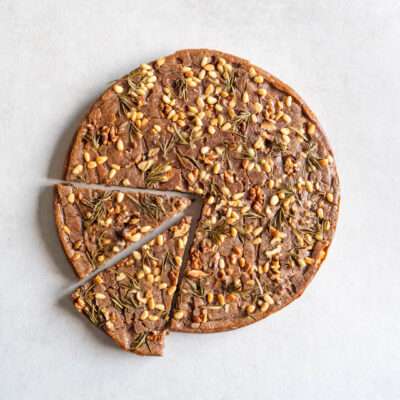Castagnaccio (Tuscan Chestnut Cake)

Amongst many other treasures, Tuscany is known for an abundance of chestnuts. Once considered a food of the poor, who foraged the fallen nuts in the forests, dried them and ground them into flour, chestnuts are nowadays considered somewhat of a luxury. And as such, this Tuscan chestnut cake has long conquered the heart of many Italians, while still remaining fairly unknown elsewhere.
Usually made during fall, when chestnuts are available and the flour is at its freshest, Castagnaccio is an unleavened cake that happens to be both traditionally vegan and gluten-free. It is flavoured with walnuts, pine nuts, raisins and, surprisingly, rosemary. The combination of sweet and savoury turns this elegant cake into a unique dessert.
I first learned about Castagnaccio while travelling through Tuscany on my search for traditional plant-based dishes. Knowing all too well about this precious secret that Italians have mostly kept to themselves, the wonderful Giulia Scarpaleggia invited me to her studio kitchen and showed me how the cake is prepared. Giulia shares these and many more secrets as well as popular classics across her blog, Jul’s Kitchen, a timeless deep-dive into the richness of Italian cuisine.
Castagnaccio tastes heavenly by itself, but the angels begin to sing a little louder if you serve it alongside Italian dessert wine like Vin Santo.
Storage
Keep any leftovers in an airtight container for 1-2 days.

serves 8
Ingredients
-
50g raisins
-
60g walnuts
-
2 sprigs of rosemary
-
300g chestnut flour
-
1/3 tsp salt
-
420 ml water
-
50g pine nuts
-
6 tbsp extra virgin olive oil
Method
Preheat the oven to 180°C.
Add the raisins to a small bowl, cover with warm water and leave to soak for 10 minutes. In the meantime, roughly chop the walnuts and strip the rosemary leaves. Grease a 25cm cake tin with 2 tbsp of the olive oil.
Sift the chestnut flour into a large bowl, add the salt and gradually whisk in the water until the flour has dissolved evenly. Whisk in 2 tbsp of olive oil, then drain the raisins, squeeze out the remaining water and stir them into the batter along with about half of the walnuts and pine nuts. Pour the batter into the cake tin and top it with the remaining nuts and the rosemary. Then drizzle over the remaining 2 tbsp of olive oil.
Bake for 30-35 minutes or until the top feels firm and just begins to crack. Then leave it to cool for 10 minutes, before removing it from the cake tin and cutting it into slices.
Storage: Keep any leftovers in an airtight container for 1-2 days.
As an Amazon Associate I receive a small commission from affiliate links on this page.

Castagnaccio (Tuscan Chestnut Cake)
Ingredients
- 50 g raisins
- 60 g walnuts
- 2 sprigs of rosemary
- 300 g chestnut flour
- 1/3 tsp salt
- 420 ml water
- 50 g pine nuts
- 6 tbsp extra virgin olive oil
Instructions
- Pre-heat the oven to 180°C.
- Add the raisins to a small bowl, cover with warm water and leave to soak for 10 minutes. In the meantime, roughly chop the walnuts and strip the rosemary leaves. Grease a 25cm cake tin with 2 tbsp of the olive oil.
- Sift the chestnut flour into a large bowl, add the salt and gradually whisk in the water until the flour has dissolved evenly. Whisk in 2 tbsp of olive oil, then drain the raisins, squeeze out the remaining water and stir them into the batter along with about half of the walnuts and pine nuts. Pour the batter into the cake tin and top it with the remaining nuts and the rosemary. Then drizzle over the remaining 2 tbsp of olive oil.
- Bake for 30-35 minutes or until the top feels firm and just begins to crack. Then leave it to cool for 10 minutes, before removing it from the cake tin and cutting it into slices.

Never thought I’d like this based on the ingredients (like rosemary and raisins) but I tried this last weekend and it was absolutely delicious! My family loved it too since it was gone within minutes. I’m already planning to make it again this weekend. So easy to make as well!
One of the best desserts to fight that fear of raisins! ????